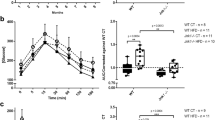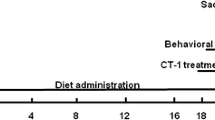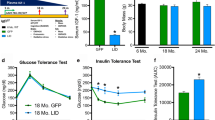Abstract
The insulin receptor substrates (IRS) are adapter proteins mediating insulin's and IGF1's intracellular effects. Recent data suggest that IRS2 in the central nervous system (CNS) is involved in regulating fuel metabolism as well as memory formation. The present study aims to specifically define the role of chronically increased IRS2-mediated signal transduction in the CNS. We generated transgenic mice overexpressing IRS2 specifically in neurons (nIRS2 tg) and analyzed these in respect to energy metabolism, learning, and memory. Western blot (WB) analysis of nIRS2 tg brain lysates revealed increased IRS2 downstream signaling. Histopathological investigation of nIRS2 tg mice proved unaltered brain development and structure. Interestingly, nIRS2 tg mice showed decreased voluntary locomotoric activity during dark phase accompanied with decreased energy expenditure (EE) leading to increased fat mass. Accordingly, nIRS2 tg mice develop insulin resistance and glucose intolerance during aging. Exploratory behavior, motor function as well as food and water intake were unchanged in nIRS2 tg mice. Surprisingly, increased IRS2-mediated signals did not change spatial working memory in the T-maze task. Since FoxO1 is a key mediator of IRS2-transmitted signals, we additionally generated mice expressing a dominant negative mutant of FoxO1 (FoxO1DN) specifically in neurons. This mutant mimics the effect of increased IRS2 signaling on FoxO-mediated transcription. Interestingly, the phenotype observed in nIRS2 tg mice was not present in FoxO1DN mice. Therefore, increased neuronal IRS2 signaling causes decreased locomotoric activity in the presence of unaltered exploratory behavior and motor coordination that might lead to increased fat mass, insulin resistance, and glucose intolerance during aging independent of FoxO1-mediated transcription.









Similar content being viewed by others
References
Brunet A, Bonni A, Zigmond MJ, Lin MZ, Juo P, Hu LS, Anderson MJ, Arden KC, Blenis J, Greenberg ME (1999) Akt promotes cell survival by phosphorylating and inhibiting a Forkhead transcription factor. Cell 96(6):857–868
Burgering BM (2008) A brief introduction to FOXOlogy. Oncogene 27(16):2258–2262
Burks DJ, Font de Mora J, Schubert M, Withers DJ, Myers MG, Towery HH, Altamuro SL, Flint CL, White MF (2000) IRS-2 pathways integrate female reproduction and energy homeostasis. Nature 407(6802):377–382
Cheng Z, White MF (2012) The AKTion in non-canonical insulin signaling. Nat Med 18(3):351–353
Cheng Z, Guo S, Copps K, Dong X, Kollipara R, Rodgers JT, Depinho RA, Puigserver P, White MF (2009) Foxo1 integrates insulin signaling with mitochondrial function in the liver. Nat Med 15(11):1307–1311
Chirivella L, Cano-Jaimez M, Perez-Sanchez F, Herraez L, Carretero J, Farinas I, Burks DJ, Kirstein M (2012) IRS2 signalling is required for the development of a subset of sensory spinal neurons. Eur J Neurosci 35(3):341–352
Choudhury AI, Heffron H, Smith MA, Al-Qassab H, Xu AW, Selman C, Simmgen M, Clements M, Claret M, Maccoll G, Bedford DC, Hisadome K, Diakonov I, Moosajee V, Bell JD, Speakman JR, Batterham RL, Barsh GS, Ashford ML, Withers DJ (2005) The role of insulin receptor substrate 2 in hypothalamic and beta cell function. J Clin Invest 115(4):940–950
Cohen E, Paulsson JF, Blinder P, Burstyn-Cohen T, Du D, Estepa G, Adame A, Pham HM, Holzenberger M, Kelly JW, Masliah E, Dillin A (2009) Reduced IGF-1 signaling delays age-associated proteotoxicity in mice. Cell 139(6):1157–1169
Craft S, Baker LD, Montine TJ, Minoshima S, Watson GS, Claxton A, Arbuckle M, Callaghan M, Tsai E, Plymate SR, Green PS, Leverenz J, Cross D, Gerton B (2012) Intranasal insulin therapy for Alzheimer disease and amnestic mild cognitive impairment: a pilot clinical trial. Arch Neurol 69(1):29–38
Deacon RM, Rawlins JN (2006) T-maze alternation in the rodent. Nat Protoc 1(1):7–12
Dhamoon MS, Noble JM, Craft S (2009) Intranasal insulin improves cognition and modulates beta-amyloid in early AD. Neurology 72(3):292–293, author reply 293–4
Dong XC, Copps KD, Guo S, Li Y, Kollipara R, DePinho RA, White MF (2008) Inactivation of hepatic Foxo1 by insulin signaling is required for adaptive nutrient homeostasis and endocrine growth regulation. Cell Metab 8(1):65–76
Eggan K, Akutsu H, Loring J, Jackson-Grusby L, Klemm M, Rideout WM 3rd, Yanagimachi R, Jaenisch R (2001) Hybrid vigor, fetal overgrowth, and viability of mice derived by nuclear cloning and tetraploid embryo complementation. Proc Natl Acad Sci U S A 98(11):6209–6214
Freude S, Leeser U, Muller M, Hettich MM, Udelhoven M, Schilbach K, Tobe K, Kadowaki T, Kohler C, Schroder H, Krone W, Bruning JC, Schubert M (2008) IRS-2 branch of IGF-1 receptor signaling is essential for appropriate timing of myelination. J Neurochem 107(4):907–917
Freude S, Schilbach K, Schubert M (2009a) The role of IGF-1 receptor and insulin receptor signaling for the pathogenesis of Alzheimer's disease: from model organisms to human disease. Curr Alzheimer Res 6(3):213–223
Freude S, Hettich MM, Schumann C, Stohr O, Koch L, Kohler C, Udelhoven M, Leeser U, Muller M, Kubota N, Kadowaki T, Krone W, Schroder H, Bruning JC, Schubert M (2009b) Neuronal IGF-1 resistance reduces Abeta accumulation and protects against premature death in a model of Alzheimer's disease. FASEB J 23(10):3315–3324
Freude S, Schilbach K, Hettich MM, Bronneke HS, Zemva J, Krone W, Schubert M (2012) Neuron-specific deletion of a single copy of the insulin-like growth factor-1 receptor gene reduces fat accumulation during aging. Horm Metab Res 44(2):99–104
Furuyama T, Nakazawa T, Nakano I, Mori N (2000) Identification of the differential distribution patterns of mRNAs and consensus binding sequences for mouse DAF-16 homologues. Biochem J 349(Pt 2):629–634
Hallschmid M, Benedict C, Schultes B, Fehm HL, Born J, Kern W (2004) Intranasal insulin reduces body fat in men but not in women. Diabetes 53(11):3024–3029
He XP, Kotloski R, Nef S, Luikart BW, Parada LF, McNamara JO (2004) Conditional deletion of TrkB but not BDNF prevents epileptogenesis in the kindling model. Neuron 43(1):31–42
Irvine EE, Drinkwater L, Radwanska K, Al-Qassab H, Smith MA, O'Brien M, Kielar C, Choudhury AI, Krauss S, Cooper JD, Withers DJ, Giese KP (2011) Insulin receptor substrate 2 is a negative regulator of memory formation. Learn Mem 18(6):375–383
Jacobs FM, van der Heide LP, Wijchers PJ, Burbach JP, Hoekman MF, Smidt MP (2003) FoxO6, a novel member of the FoxO class of transcription factors with distinct shuttling dynamics. J Biol Chem 278(38):35959–35967
Kappeler L, De Magalhaes FC, Dupont J, Leneuve P, Cervera P, Perin L, Loudes C, Blaise A, Klein R, Epelbaum J, Le Bouc Y, Holzenberger M (2008) Brain IGF-1 receptors control mammalian growth and lifespan through a neuroendocrine mechanism. PLoS Biol 6(10):e254
Killick R, Scales G, Leroy K, Causevic M, Hooper C, Irvine EE, Choudhury AI, Drinkwater L, Kerr F, Al-Qassab H, Stephenson J, Yilmaz Z, Giese KP, Brion JP, Withers DJ, Lovestone S (2009) Deletion of Irs2 reduces amyloid deposition and rescues behavioural deficits in APP transgenic mice. Biochem Biophys Res Commun 386(1):257–262
Kim B, McLean LL, Philip SS, Feldman EL (2011) Hyperinsulinemia induces insulin resistance in dorsal root ganglion neurons. Endocrinology 152(10):3638–3647
Kitamura T, Kitamura YI, Funahashi Y, Shawber CJ, Castrillon DH, Kollipara R, DePinho RA, Kitajewski J, Accili D (2007) A Foxo/Notch pathway controls myogenic differentiation and fiber type specification. J Clin Invest 117(9):2477–2485
Konner AC, Hess S, Tovar S, Mesaros A, Sanchez-Lasheras C, Evers N, Verhagen LA, Bronneke HS, Kleinridders A, Hampel B, Kloppenburg P, Bruning JC (2011) Role for insulin signaling in catecholaminergic neurons in control of energy homeostasis. Cell Metab 13(6):720–728
Kuhn R, Torres RM (2002) Cre/loxP recombination system and gene targeting. Methods Mol Biol 180:175–204
Lavan BE, Lane WS, Lienhard GE (1997a) The 60-kDa phosphotyrosine protein in insulin-treated adipocytes is a new member of the insulin receptor substrate family. J Biol Chem 272(17):11439–11443
Lavan BE, Fantin VR, Chang ET, Lane WS, Keller SR, Lienhard GE (1997b) A novel 160-kDa phosphotyrosine protein in insulin-treated embryonic kidney cells is a new member of the insulin receptor substrate family. J Biol Chem 272(34):21403–21407
Mao X, Fujiwara Y, Orkin SH (1999) Improved reporter strain for monitoring Cre recombinase-mediated DNA excisions in mice. Proc Natl Acad Sci U S A 96(9):5037–5042
Mesaros A, Koralov SB, Rother E, Wunderlich FT, Ernst MB, Barsh GS, Rajewsky K, Bruning JC (2008) Activation of Stat3 signaling in AgRP neurons promotes locomotor activity. Cell Metab 7(3):236–248
Moloney AM, Griffin RJ, Timmons S, O'Connor R, Ravid R, O'Neill C (2010) Defects in IGF-1 receptor, insulin receptor and IRS-1/2 in Alzheimer's disease indicate possible resistance to IGF-1 and insulin signalling. Neurobiol Aging 31(2):224–243
Sadagurski M, Cheng Z, Rozzo A, Palazzolo I, Kelley GR, Dong X, Krainc D, White MF (2011) IRS2 increases mitochondrial dysfunction and oxidative stress in a mouse model of Huntington disease. J Clin Invest 121(10):4070–4081
Saltiel AR, Kahn CR (2001) Insulin signalling and the regulation of glucose and lipid metabolism. Nature 414(6865):799–806
Schubert M, Brazil DP, Burks DJ, Kushner JA, Ye J, Flint CL, Farhang-Fallah J, Dikkes P, Warot XM, Rio C, Corfas G, White MF (2003) Insulin receptor substrate-2 deficiency impairs brain growth and promotes tau phosphorylation. J Neurosci 23(18):7084–7092
Selman C, Lingard S, Gems D, Partridge L, Withers DJ (2008) Comment on “Brain IRS2 signaling coordinates life span and nutrient homeostasis”. Science 320(5879):1012, author reply 1012
Stohr O, Hahn J, Moll L, Leeser U, Freude S, Bernard C, Schilbach K, Markl A, Udelhoven M, Krone W, Schubert M (2011a) Insulin receptor substrate-1 and −2 mediate resistance to glucose-induced caspase-3 activation in human neuroblastoma cells. Biochim Biophys Acta 1812(5):573–580
Stohr O, Schilbach K, Moll L, Hettich MM, Freude S, Wunderlich FT, Ernst M, Zemva J, Bruning JC, Krone W, Udelhoven M, Schubert M (2011b) Insulin receptor signaling mediates APP processing and beta-amyloid accumulation without altering survival in a transgenic mouse model of Alzheimer's disease. Age (Dordr)
Sun XJ, Rothenberg P, Kahn CR, Backer JM, Araki E, Wilden PA, Cahill DA, Goldstein BJ, White MF (1991) Structure of the insulin receptor substrate IRS-1 defines a unique signal transduction protein. Nature 352(6330):73–77
Sun XJ, Wang LM, Zhang Y, Yenush L, Myers MG Jr, Glasheen E, Lane WS, Pierce JH, White MF (1995) Role of IRS-2 in insulin and cytokine signalling. Nature 377(6545):173–177
Taguchi A, Wartschow LM, White MF (2007) Brain IRS2 signaling coordinates life span and nutrient homeostasis. Science 317(5836):369–372
Tschop MH, Speakman JR, Arch JR, Auwerx J, Bruning JC, Chan L, Eckel RH, Farese RV Jr, Galgani JE, Hambly C, Herman MA, Horvath TL, Kahn BB, Kozma SC, Maratos-Flier E, Muller TD, Munzberg H, Pfluger PT, Plum L, Reitman ML, Rahmouni K, Shulman GI, Thomas G, Kahn CR, Ravussin E (2012) A guide to analysis of mouse energy metabolism. Nat Methods 9(1):57–63
Udelhoven M, Pasieka M, Leeser U, Krone W, Schubert M (2010a) Neuronal insulin receptor substrate 2 (IRS2) expression is regulated by ZBP89 and SP1 binding to the IRS2 promoter. J Endocrinol 204(2):199–208
Udelhoven M, Leeser U, Freude S, Hettich MM, Laudes M, Schnitker J, Krone W, Schubert M (2010b) Identification of a region in the human IRS2 promoter essential for stress induced transcription depending on SP1, NFI binding and ERK activation in HepG2 cells. J Mol Endocrinol 44(2):99–113
White MF (2003) Insulin signaling in health and disease. Science 302(5651):1710–1711
Withers DJ, Burks DJ, Towery HH, Altamuro SL, Flint CL, White MF (1999) Irs-2 coordinates Igf-1 receptor-mediated beta-cell development and peripheral insulin signalling. Nat Genet 23(1):32–40
Yamada M, Ohnishi H, Sano S, Nakatani A, Ikeuchi T, Hatanaka H (1997) Insulin receptor substrate (IRS)-1 and IRS-2 are tyrosine-phosphorylated and associated with phosphatidylinositol 3-kinase in response to brain-derived neurotrophic factor in cultured cerebral cortical neurons. J Biol Chem 272(48):30334–30339
Yenush L, White MF (1997) The IRS-signalling system during insulin and cytokine action. Bioessays 19(6):491–500
Zemva J, Schubert M (2011) Central insulin and insulin-like growth factor-1 signaling—implications for diabetes associated dementia. Curr Diabetes Rev 7(5):356–366
Zemva J, Schilbach K, Stöhr O, Moll L, Franko A, Krone W, Wiesner RJ and Schubert M (2012) Central FoxO3a and FoxO6 expression is downregulated in obesity induced diabetes but not in aging. Exp Clin Endocrinol Diabetes 120(6):340–350
Zhu Y, Romero MI, Ghosh P, Ye Z, Charnay P, Rushing EJ, Marth JD, Parada LF (2001) Ablation of NF1 function in neurons induces abnormal development of cerebral cortex and reactive gliosis in the brain. Genes Dev 15(7):859–876
Acknowledgments
This work was supported by AFI #08813. JZ was supported by a student's grant of the Medical Faculty, University of Cologne. We thank Andre Kleinridders for his kind introduction and troubleshooting in transgenic mouse generation. Also, we thank Thomas Wunderlich for kindly providing the pCAGGS targeting vector. Thanks also to Jens Alber for excellent technical assistance, Prof. Wilhelm Stoffel for providing the T-maze, and Prof. Martina Deckert and Mariana Carstov for advice and help on immunohistochemistry.
Author information
Authors and Affiliations
Corresponding author
Additional information
J. Zemva and M. Udelhoven contributed equally to this study.
Electronic supplementary material
Below is the link to the electronic supplementary material.
Suppl. Fig. 1
Phenotype of WT, nIRS2 tg and homozygous (homo) nIRS2 tg mice at the age of 60 weeks. Transgenic mice appear to have increased abdominal fat mass during aging. The phenotype was more pronounced in homozygous compared to heterozygous mice (JPEG 41 kb)
High Resolution Image
(TIFF 3145 kb)
Suppl. Fig. 2
Exploratory behavior and motor coordination of male nIRS2 tg mice and respective controls. a Open field test. b Elevated O-Maze test. c Rotarod test, accel: latency to fall [s] at constantly increasing rounds per minute (rpm). Data are expressed as means ± SEM, n = 6 per group, * p < 0.05 (Student's t test), age: 40 weeks (JPEG 45 kb)
High Resolution Image
(TIFF 728 kb)
Suppl. Fig. 3
Spatial memory and hippocampal function of male nIRS2 tg mice and respective controls. a Enclosed T-maze test. Data represent means ± SEM, n = 6 per group, * p < 0.05 (Student's t test), age: 20 and 100 weeks (JPEG 7 kb)
High Resolution Image
(TIFF 130 kb)
About this article
Cite this article
Zemva, J., Udelhoven, M., Moll, L. et al. Neuronal overexpression of insulin receptor substrate 2 leads to increased fat mass, insulin resistance, and glucose intolerance during aging. AGE 35, 1881–1897 (2013). https://doi.org/10.1007/s11357-012-9491-x
Received:
Accepted:
Published:
Issue Date:
DOI: https://doi.org/10.1007/s11357-012-9491-x




